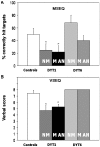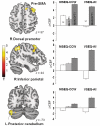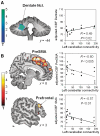Impaired sequence learning in dystonia mutation carriers: a genotypic effect
- PMID: 21515903
- PMCID: PMC3097890
- DOI: 10.1093/brain/awr060
Impaired sequence learning in dystonia mutation carriers: a genotypic effect
Abstract
Abnormalities in motor sequence learning have been observed in non-manifesting carriers of the DYT1 dystonia mutation. Indeed, motor sequence learning deficits in these subjects have been associated with increased cerebellar activation during task performance. In the current study, we determined whether similar changes are also present in clinically manifesting DYT1 carriers as well as in carriers of other primary dystonia mutations such as DYT6. Additionally, we determined whether sequence learning performance and associated brain activation in these subjects correlate with previously described genotype-related abnormalities of cerebellar pathway integrity and striatal D2 dopamine receptor binding. Nineteen DYT1 carriers (10 non-manifesting DYT1: 51.5±15.1 years; nine manifesting DYT1: 46.1±15.1 years) and 12 healthy control subjects (42.8±15.3 years) were scanned with H2(15)O positron emission tomography while performing controlled sequence learning and reference tasks. Eleven DYT6 carriers (four non-manifesting DYT6: 38.0±22.1; seven manifesting DYT6: 35.3±14.2 years) were evaluated during task performance without concurrent imaging. DYT1 and DYT6 carriers also underwent diffusion tensor magnetic resonance imaging for the assessment of tract integrity and 11C-raclopride positron emission tomography to measure caudate/putamen D2 receptor binding. These imaging measures were correlated with sequence learning performance and associated activation responses. Sequence learning deficits of similar magnitude were observed in manifesting and non-manifesting DYT1 carriers. In contrast, learning deficits were not detected in DYT6 carriers, irrespective of clinical penetrance. Affected DYT1 carriers exhibited significant increases in sequence learning-related activation in the left lateral cerebellar cortex and in the right premotor and inferior parietal regions. Increases in premotor cortical activation observed in the mutation carriers correlated with reductions in cerebellar pathway integrity measured using magnetic resonance diffusion tensor imaging and probabilistic tractography. Additionally, the cerebellar tract changes correlated with reductions in dentate nucleus activation recorded during task performance. Sequence learning performance and task-related activation responses did not correlate with striatal D2 receptor binding. In summary, we found that sequence learning deficits and concomitant increases in cerebellar activation are specific features of the DYT1 genotype. The close relationship between reduced cerebellar pathway integrity and increased learning-related activation of the premotor cortex is compatible with the view of DYT1 dystonia as a neurodevelopmental circuit disorder.
Figures




Similar articles
-
Increased sensorimotor network activity in DYT1 dystonia: a functional imaging study.Brain. 2010 Mar;133(Pt 3):690-700. doi: 10.1093/brain/awq017. Epub 2010 Mar 5. Brain. 2010. PMID: 20207699 Free PMC article.
-
Abnormal striatal and thalamic dopamine neurotransmission: Genotype-related features of dystonia.Neurology. 2009 Jun 16;72(24):2097-103. doi: 10.1212/WNL.0b013e3181aa538f. Neurology. 2009. PMID: 19528516 Free PMC article.
-
Increased cerebellar activation during sequence learning in DYT1 carriers: an equiperformance study.Brain. 2008 Jan;131(Pt 1):146-54. doi: 10.1093/brain/awm243. Epub 2007 Oct 18. Brain. 2008. PMID: 17947338 Free PMC article.
-
Abnormal structure-function relationships in hereditary dystonia.Neuroscience. 2009 Nov 24;164(1):220-9. doi: 10.1016/j.neuroscience.2008.12.041. Epub 2009 Jan 1. Neuroscience. 2009. PMID: 19162138 Free PMC article. Review.
-
[New approaches in dystonia (clinical features, genetic issues and pathophysiology].Bull Acad Natl Med. 2011 Apr-May;195(4-5):921-34; discussion 934. Bull Acad Natl Med. 2011. PMID: 22375360 Review. French.
Cited by
-
Defective cerebellar control of cortical plasticity in writer's cramp.Brain. 2013 Jul;136(Pt 7):2050-62. doi: 10.1093/brain/awt147. Brain. 2013. PMID: 23801734 Free PMC article. Clinical Trial.
-
A dystonia mouse model with motor and sequencing deficits paralleling human disease.Behav Brain Res. 2022 May 24;426:113844. doi: 10.1016/j.bbr.2022.113844. Epub 2022 Mar 15. Behav Brain Res. 2022. PMID: 35304183 Free PMC article.
-
Normal motor adaptation in cervical dystonia: a fundamental cerebellar computation is intact.Cerebellum. 2014 Oct;13(5):558-67. doi: 10.1007/s12311-014-0569-0. Cerebellum. 2014. PMID: 24872202 Free PMC article.
-
The visual perception of natural motion: abnormal task-related neural activity in DYT1 dystonia.Brain. 2015 Dec;138(Pt 12):3598-609. doi: 10.1093/brain/awv282. Epub 2015 Sep 29. Brain. 2015. PMID: 26419798 Free PMC article.
-
Electrophysiological characterization of the striatal cholinergic interneurons in Dyt1 ΔGAG knock-in mice.Dystonia. 2022 Jul;1:10557. doi: 10.3389/dyst.2022.10557. Epub 2022 Jul 21. Dystonia. 2022. PMID: 36329866 Free PMC article.
References
-
- Asanuma K, Ma Y, Okulski J, Dhawan V, Chaly T, Carbon M, et al. Decreased striatal D2 receptor binding in non-manifesting carriers of the DYT1 dystonia mutation. Neurology. 2005;64:347–9. - PubMed
-
- Aso K, Hanakawa T, Aso T, Fukuyama H. Cerebro-cerebellar interactions underlying temporal information processing. J Cogn Neurosci. 2010;22:2913–25. - PubMed
Publication types
MeSH terms
Substances
Grants and funding
LinkOut - more resources
Full Text Sources
Other Literature Sources
Medical

